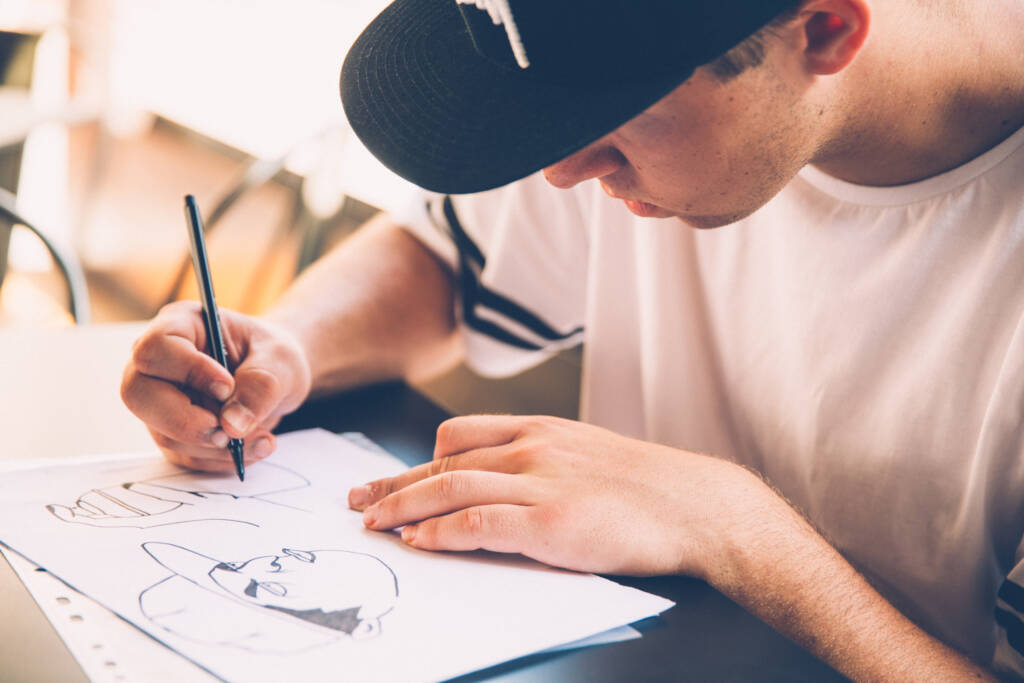
Drawing 1 Project

Imagine bringing your ideas to life while collaborating with a professional illustrator! Or picture yourself exploring artistic techniques with a concept artist. If you’re excited about applying your creativity to real-world careers, our VLACS Projects are the perfect fit for you!
This engaging learning pathway allows students to explore various career fields while mastering key concepts and skills. For each competency, you can choose to complete a pre-designed project that simulates real-life career tasks or create your own unique learning experience. Regardless of your choice, you’ll engage in thorough research and apply what you learn to authentic career scenarios.
With the pre-designed projects, you’ll tackle real-world tasks that align with each competency. If you decide to design your own experience, you’ll collaborate with your instructor and a mentor to design and complete meaningful career tasks that demonstrate your understanding. We have partnered with hundreds of mentors you can work with if you choose to design your own experience. Check out our Career Mentor Catalog here.
Take a look at the competency statements and pre-designed options below. We’re excited to support you on this exciting and open-ended learning adventure!
Note: This is a project-based course. If you’re looking for a traditional format, please return to the learning catalog and select the course.
Projects
Toy Designer
Competency: Forms in Drawing
You are a toy designer who creates innovative and visually appealing designs that captivate the imagination of children and collectors alike. Your role involves mastering artistic techniques to convey form and depth, as demonstrated through form in drawing.
You will create a toy concept sketch and supporting notes that will describe three-dimensional shapes, explain the use of a light source in a drawing, and describe the importance of implementing a variety of values in a drawing.
Shoe Designer
Competency: Line in Drawing
You are a shoe designer who crafts innovative and stylish footwear designs that combine form and function. Your role involves using precise drawing techniques to communicate your concepts effectively, as demonstrated in line in drawing.
You will create a shoe design sketch and supporting notes that will describe line weight in a drawing, explain characteristics of line types in a drawing, and explain the application of line types in a drawing.
Architect
Competency: Perspective in Drawing
You are an architect who designs functional and aesthetically pleasing structures that shape the built environment. Your role involves mastering perspective drawing techniques to create accurate and visually compelling architectural plans, as demonstrated in perspective in drawing.
You will create an architectural concept sketch and supporting notes that will compare one-point and two-point perspective in drawing, explain the application of one-point perspective in drawing, and explain the application of two-point perspective in drawing.
Fine Artist
Competency: Still Life Drawing
You are an artist who creates still life drawings that capture the beauty and detail of everyday objects. Your role involves using artistic techniques to convey depth, balance, and proportion, as demonstrated in still life drawing.
You will create a still life drawing and supporting notes that will describe the features of a still life drawing, explain the use of space in a still life drawing, and analyze the role of proportion in a still life drawing.
Animator
Competency: Surrealism in Drawing
You are an animator who incorporates Surrealism into your creative projects to produce visually compelling and imaginative animations. Your role involves understanding and applying Surrealist concepts to evoke emotion and tell unique stories, as demonstrated in Surrealism in drawing.
You will create a Surrealism-inspired drawing and supporting notes that will explain the history of Surrealist art, describe the characteristics of Surrealist art, and explain the application of Surrealist imagery.
Competencies
Form in Drawing
Students will demonstrate an understanding of form in drawing by describing three-dimensional shapes, explaining the use of a light source in a drawing, and describing the importance of implementing a variety of values in a drawing.
Line in Drawing
Students will demonstrate an understanding of line in drawing by describing line weight in a drawing, explaining characteristics of line types in a drawing, and explaining the application of line types in a drawing.
Perspective in Drawing
Students will demonstrate an understanding of perspective in drawing by comparing one-point and two-point perspectives in drawing, explaining the application of one-point perspective in drawing, and explaining the application of two-point perspective in drawing.
Still Life Drawing
Students will demonstrate an understanding of still life drawing by describing the features of a still life drawing, explaining the use of space in a still life drawing, and analyzing the role of proportion in a still life drawing.
Surrealism in Drawing
Students will demonstrate an understanding of Surrealism in drawing by explaining the history of Surrealist art, describing the characteristics of Surrealist art, and explaining the application of Surrealist imagery.
